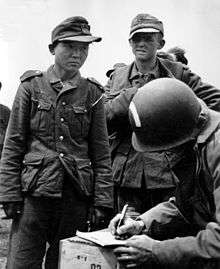Yang Kyoungjong
| Yang Kyoungjong | |
|---|---|
 Yang Kyongjong (left) in Wehrmacht attire following capture by American paratroopers in June 1944 after D-Day | |
| Born | March 3, 1920 |
| Died |
April 7, 1992 (aged 72) Illinois, United States |
| Allegiance |
|
| Years of service |
|
| Battles/wars | |
| Yang Kyoungjong | |
| Hangul | 양경종 |
|---|---|
| Hanja | 楊景鍾 |
| Revised Romanization | Yang Gyeong-jong |
| McCune–Reischauer | Yang Kyŏng-chong |
Yang Kyoungjong (March 3, 1920 – April 7, 1992) was a Korean soldier who fought in the Imperial Japanese Army, the Soviet Red Army, and later the German Wehrmacht during World War II.[1][2][3][4]
In 1938, at the age of 18, Yang was in Manchuria when he was conscripted into the Kwantung Army of the Imperial Japanese Army to fight against the Soviet Union. At the time Korea was ruled by Japan. During the Battles of Khalkhin Gol, he was captured by the Soviet Red Army and sent to a labour camp. Because of the manpower shortages faced by the Soviets in its fight against Nazi Germany, in 1942 he was pressed into fighting in the Red Army along with thousands of other prisoners, and was sent to the European eastern front.[1][3]
In 1943, he was captured by Wehrmacht soldiers in Ukraine during the Third Battle of Kharkov, and was then pressed into fighting for Germany. Yang was sent to Occupied France to serve in a battalion of Soviet prisoners of war known as an "Eastern Battalion", located on the Cotentin peninsula in Normandy, close to Utah Beach. After the D-Day landings in northern France by the Allied forces, Yang was captured by paratroopers of the United States Army in June 1944. The Americans initially believed him to be a Japanese in German uniform; at the time, Lieutenant Robert Brewer of the 506th Parachute Infantry Regiment, 101st Airborne Division, reported that his regiment had captured four Asians in German uniform after the Utah Beach landings, and that initially no one was able to communicate with them. Yang was sent to a prison camp in Britain and later transferred to a camp in the United States. After he was released at the end of the war, he settled in Illinois where he lived until his death in 1992.[1][2][3] He is survived by two sons and one daughter, but did not tell them his story during his lifetime.
Controversy
In December 2005, SBS (Seoul Broadcasting System) aired a documentary on the existence of the Asian soldiers who served Nazi Germany and were captured by Allied forces. The documentary concluded that, despite the fact that there were indeed Asian Nazi soldiers captured during the World War II, there was no clear evidence indicating the existence of an individual named Yang Kyoungjong.[5]
See also
- Lauri Törni – Finnish army captain who served in the Finnish Army, Waffen SS and United States Army
- Joseph Beyrle – American soldier who fought in both the US Army and Soviet Red Army during World War II
- Aleksandr Pavlovich Min – ethnic Korean military officer in the Soviet Red Army during World War II, posthumous recipient of the Hero of the Soviet Union (in Russian)
- Ivor Thord-Gray – Participated in 13 different wars covering several continents.
- Apolonio de Carvalho – Brazilian Army officer who fought alongside the Republicans during the Spanish Civil War and later on reached the rank of colonel in the French Army fighting Nazi Occupation.
- My Way – 2011 South Korean movie inspired by Yang's story.
References
- 1 2 3 Antony Beevor, 2 June 2012, The soldier forced to fight for three sides in WW2... the ultimate tale of a man who became a reluctant veteran of the Japanese, German and Soviet armies, Daily Mail
- 1 2 26 June 2012, What's New About WW2, Huffington Post
- 1 2 3 Ambrose, Stephen (1994). D-Day June 6, 1944: The Climactic Battle of WWII. Simon & Schuster. ISBN 978-0671673345
- ↑ Antony Beevor, (2012). The Second World War. Weidenfeld and Nicholson. ISBN 0297860704
- ↑ "다시보기 : SBS 스페셜". wizard2.sbs.co.kr. Retrieved 2016-06-06.